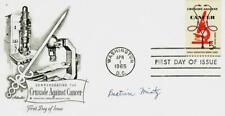"Genetic Engineering" Beatrice Mintz Hand Signed FDC Dated 1965 For Sale

When you click on links to various merchants on this site and make a purchase, this can result in this site earning a commission. Affiliate programs and affiliations include, but are not limited to, the eBay Partner Network.
"Genetic Engineering" Beatrice Mintz Hand Signed FDC Dated 1965:
$999.99
Up for sale a VERY RARE! "Genetic Engineering" Beatrice Mintz Hand Signed First Day Cover Dated 1965.
ES-6960
Beatrice Mintz (born
January 24, 1921 in New York has contributed to the understanding
of genetic modification, cellular differentiation and
cancer, particularly melanoma. Mintz was a pioneer of genetic
engineering techniques, and was among the first scientists to In 1996 she shared the
inaugural March of
Dimes Prize in Developmental Biology with Ralph L. Brinster for their work in developing transgenic
mice. Much of her career has been spent at the Fox Chase Cancer Center in
Philadelphia where, in 2002, she was named to the Jack Schultz Chair in Basic
Science. Mintz is a member of both the United
States National Academy of Sciences and the Pontifical Academy of
Sciences. Beatrice Mintz was born to Samuel and Janie Stein Mintz, a
Jewish family from Mikulintsy, Austria which was part of what was then called
Galicia. She graduated magna
cum laude from Hunter College in 1941 and then took graduate
studies at New York University for
a year. Because of anti Semitic admissions quotas in the colleges on the east
coast, she attended the University of Iowa where
she received a Master's degree in
1944 and a Ph.D. in 1946, studying amphibians under Emil Witschi. After graduation, Mintz
accepted a Professorship in Biological Science at the University of Chicago (1946–60; interrupted by studies
abroad: Mintz was awarded a Fulbright research fellowship at the universities
of Paris and Strasbourg in 1951). In 1960 she moved to the Institute
for Cancer Research of the Lankenau Hospital Research
Institute, which became the Fox Chase Cancer Center in
1974, where she remains on faculty. In the mid 1950s, Mintz switched her
research focus from amphibians to mammals and became a pioneer in
mammalian transgenesis. In 1965
she became an adjunct professor at the University of Pennsylvania.
Mintz and Kristoph Tarkowski independently made the first mouse embryonic
chimeras in the 1960s by aggregating two embryos at the eight-cell stage. The resultant mice developed normally
and their tissues were a mixture of cells derived from the two donor embryos. Mintz went on to create viable
chimeric embryos containing blastomeres from up to fifteen different laboratory mice. She developed a technique that
involved mixing cells from a black mouse strain into the blastocysts of white or brown mice in vitro. She then surgically transferred these early
embryos into surrogate mothers and, after birth, traced the tissue contribution
of each cell type made by studying the coat colour. Her cell fusion technique was
successful where others had failed due to the choice to remove the zona pellucida with pronase treatment, rather than physically. Since 1967
Mintz has created over 25,000 offspring using this technique.Mintz also
demonstrated could be reprogrammed to contribute to a healthy mouse when combined with
normal mouse embryo cells through eight years of experiments
utilizing some of the first pluripotent stem cell cultures
ever made. Mintz
and Rudolf Jaenisch published
a technological breakthrough in 1974. Jaenisch was a post-doctoral researcher
in Princeton University at
the time and was interested in why only certain types of cancer occurred when
he injected adult mice with viruses. Inspired by Mintz's earlier work, he
wanted to know whether injecting virus into early-stage embryos would result in
the DNA being incorporated, and what types of cancer would occur. Mintz
agreed to work with Jaenisch, who joined her lab as a visiting fellow for 9
months. They showed that DNA from a virus, SV40,
could be integrated into the DNA of developing mice and persist into adulthood
without apparent tumor formation. Although only somatic cells were affected,
meaning the DNA would not be passed on to future generations, these were the
first mice ever made with foreign DNA and this experiment proved healthy genetically modified
mammals could be created by viral infection. Using these
techniques Mintz was able to establish the genetic basis of certain kinds of
cancer and in 1993 she produced the first mouse model of human malignant melanoma.

Related Items:
"Genetic Engineering" Beatrice Mintz Hand Signed FDC Dated 1965
$699.99
Doug Sneyd Original Art Prelim Playboy Gag Rough Genetic Engineering in College
$199.99
Boy-1 #1-4 VF/NM complete series - sci fi genetic engineering company - IDW set
$9.99



